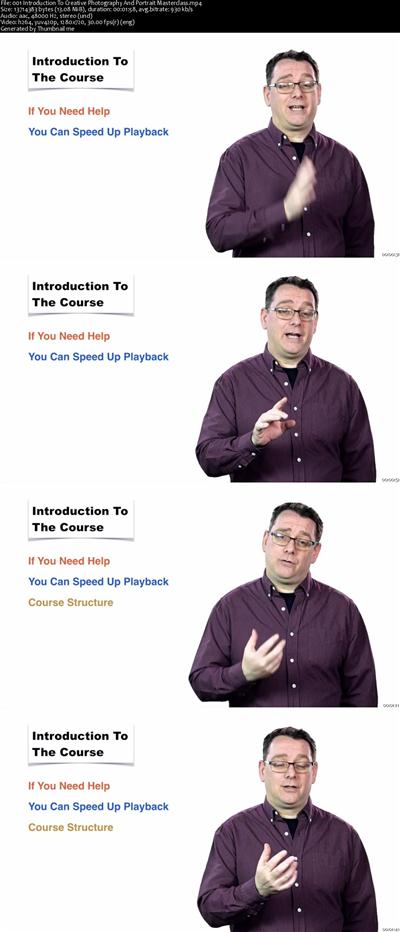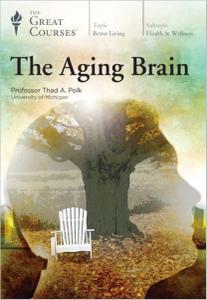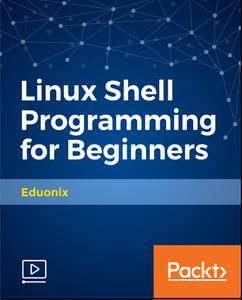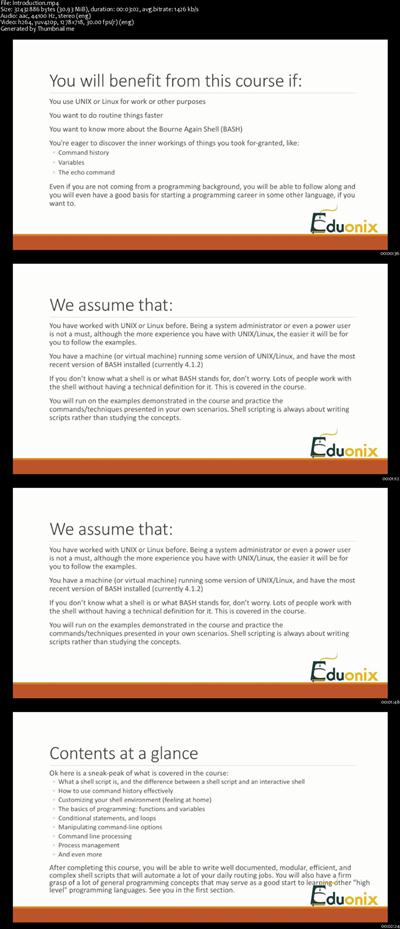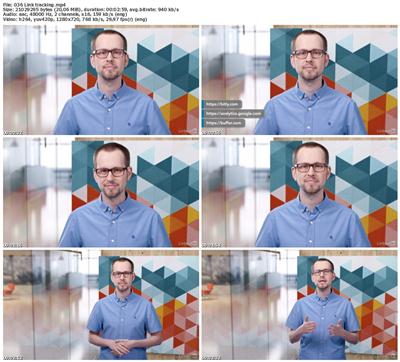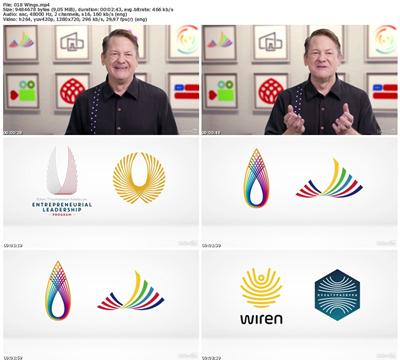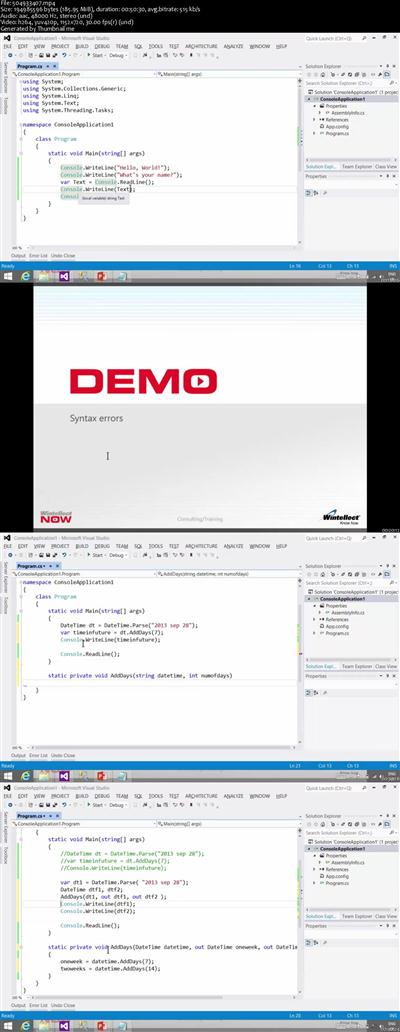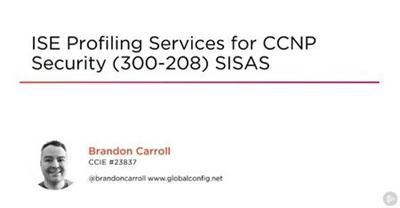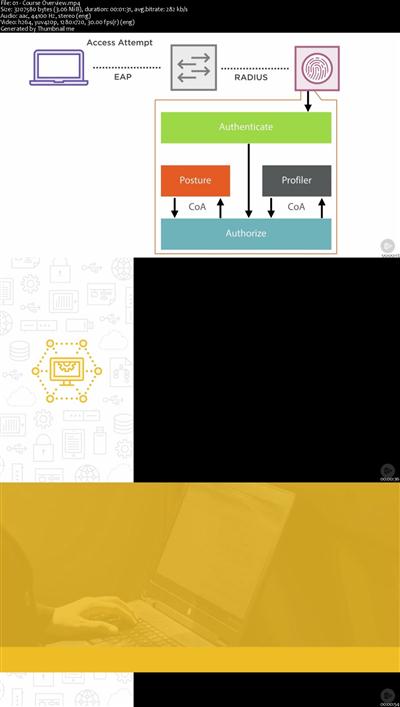Photography Composition & Portrait Photography Masterclass
MP4 | Video: AVC 1280x720 | Audio: AAC 44KHz 2ch | Duration: 11.5 Hours | Lec: 138 | 3.83 GB
Genre: eLearning | Language: English
Photography - Composition - Photography Lighting - Studio Photography - Portrait Photography - Street Photography
Do You Have A Love For Photography?
Do you want to learn how to take beautiful, powerful and compelling images with any camera?
Are You A Beginner Photographer?
Are you a beginner photographer that wants to master the creative side of photography?
Do You Want To Learn How To Master The Visual Language And Take Images That Impress?
Have you ever wondered why some people seem gifted at photography?
Do You Want To Learn How To Take Beautiful Portraits?
Using any light or even in a studio setting?
Do You Want to Become Gifted At Photography?
Well you can do all of this and more with this Masterclass on Creative Photography.
The Hidden Photographer
Inside each of us is a hidden photographer, that wants to express themselves, that knows what is beautiful and what isn't, but wants to get out, to reveal themselves.
In this course, we will teach you how to discover that hidden photography genius locked up inside you...
----------------
The Course Comes In A Modular Format And Will Cover:
Creative Photography Part 1 - A Brief History Of Photography
Photography is it art or science?
Is it both?
Is it truth or fiction?
Should images be edited at all or left in their purest form possible thus begging the question are we taking an image or creating an image?
Why are some images better than others?
What does photography mean to you?
Learn What Undermines And Influences Photography
This course examines the relationship between the photography community and the art community and the concepts of objective and subjective beauty within art. Through learning these concepts you will be able to understand how to communicate better what it is you really wish to relay through your images so that it is more readily received by your viewers.
This course touches upon the elements of photography such as:
The Appeal To The Mind
Being The Mechanic
The Appeal To The Emotions
Observation Of Time
You will learn the interesting history of photography, how photography went from something enjoyed by the elite only, to something enjoyed by the masses. You will also learn about the great debate, how the historical different schools of thought of 'straight photography' and 'pictorialism' has influenced how we view photography even to this day.
Subjects Covered
Is it Art?
The Brief History Of Photography
The Great Debate
----------------
The Art Of Seeing - Creative Photography Composition Masterclass Part 2
Did you know that Photography has it own visual language?
And that if you understand this language you will be able to create your own powerful and compelling images?
Did you also know you have an inbuilt beauty detector within you to recognise what is beautiful?
Would like like to learn how to take what is already available within you and train yourself to see and take great images?
Learn The Laws And Crack The Code
It does not have to be a mystery as to why some people are better photographers than others. The good photographers have learned the laws of composition which dictate what is considered a poor or great image.
This course aims to identify what these laws are in an ordered universe, such as laws of light and the impact they have when creating our images.
The course also aims to inspire you to appreciate the inbuilt beauty detector within yourself that intuitively knows what makes up good composition and knows what looks nice. By moving this from a subconscious awareness to a conscious awareness you can train yourself to recognise and create great images.
You will learn the stages of how a viewer consumes an image:
The Eyes
The Mind
The Heart
The Hands
You will also learn the three essential elements of an image:
Light
Subject
Background
Lectures included:
The Ordered Universe
Beauty Detector
Let There Be Light
The Photographer's Playground
Activities
----------------
Seeing The Light - Creative Photography Composition Masterclass Part 3
Did you know that photography is all about being able to see the light?
Do you understand the different properties of hard light and soft light?
Did you know you can use these light sources to achieve very differing effects in your image?
Did you know that various lights actually have different colour temperatures which when used correctly can affect the mood of your image?
Learn To See The Light And To Embrace It
Seeing the light is the single most important skill a photographer can learn, it is the very foundation of photography.
All good photographers have learned to be observers of light, they have learned to be light hunters. If the light isn't right a good photographer won't even raise their camera.
In this course we will explore the properties and uses of both Hard Light and Soft Light. We will, through diagrams and examples of images, examine how the light is falling on the subject and reflecting back into the camera.
Light colour temperature will also be explained with a helpful diagram.
Lectures included:
Seeing The Light
Hard Light
Soft Light
Colour Temperature
----------------
Controlling The Light - Creative Photography Composition Masterclass Part 4
Did you know that as a photographer you have the ability to control the light?
That by applying some simple techniques like moving your feet, moving your subject or moving your light, you can change your images in a dramatic way?
By working the scene you have a range of effects you can create in your images which range from dramatic and powerful to intimate and gentle?
Learn To Work The Scene To Become A Master Photographer
To become a master photographer you must learn to work the scene.
In this course you will learn how to move your feet.
As a photographer you are the eyes for the viewer. Wherever you move you are taking your viewer with you. Your perspective becomes their perspective.
In this course we will examine the merits of the following perspectives with illustrative examples:
In front
Behind
From The side
Below Your Subject
Above Your Subject
Birds Eye View
The Ant View
Up Close
Macro View
Far Away
The second method of control is to move your subject. This can range from literally moving the whole subject from one location to another, to getting the subject in the case of a person to move their head subtly or express emotion.
In this course we will examine the effects the following can have when moving our subjects:
Move Your Subject
Simple Background
Providing Context
Creating Disparity
Cropping Backgrounds
Subtle Movements
Displaying Emotions
Dramatic Movements
The last option is to move the light. You will learn about the different effects achieved by the direction of where the light is coming from.
We will go through helpful examples of light direction in the virtual studio to illustrate this.
Lectures included:
Working The Scene
Moving Your Feet
Moving Your Subject
Move Your Light
----------------
Capturing The Light - Creative Photography Composition Masterclass Part 5
Did you know that a camera uses three main controls to capture light?
That each of these control levers will produce a different effect on your image?
Do you find it challenging to get the correct exposure every time?
Are you losing details in the blacks or blowing out the whites?
Do you know why sometimes a camera in auto mode will expose an image incorrectly?
Learn How To Take Control Of Capturing The Light
In this course you will learn about capturing your image using the three controls in camera which affects the capture of light, these are ISO, Shutter and Aperture.
It might be tempting to put your camera in auto mode and shoot away, however for the best results and to master your photography, it is essential to understand how these controls work manually.
This course explains how these levers relate to each other and what affects each will have when capturing your image, ranging from shallow and deep depth of the field to slow and fast capture of action and low light capture capabilities.
You will learn about setting the correct exposure including the different units of measurements used within each control.
The course will also go through the different types of cameras that you can use for photography today ranging from the smartphone to a DSLR.
Lectures included:
Your Camera
The Three Levers
ISO
The Shutter
The Aperture
Activities
----------------
Processing The Light - Creative Photography Composition Masterclass Part 6
Did you know that editing your own images will teach you how to improve your photography skills?
It is at the processing stage that you will learn where you are making mistakes and what to correct next time in camera?
Do you want to learn how to use editing to pull and push your images to achieve different effects?
Learn How To Edit Your Images For The Best Impact
Editing your images will become an essential part of your photography workflow. It will be from this process that you will learn to become a better photographer as you will learn how to get in right in camera next time.
This course will go through some essential editing features:
White Balance
Cropping
Exposure
Contrast
Filters
This course also shares a simple effective editing workflow using the above features that you can follow to get you started.
You will learn the differences between Raw and JPeg images which are the types of images produced by cameras.
Lectures included:
The Digital Darkroom
Lightroom Edit
Snapseed Edit
Activities
----------------
The Core Principles Of Composition - Creative Photography Composition Masterclass Part 7
Did you know that all around us are laws that guide and influence photographic composition?
That these laws, when applied to photography will enable you to take better images?
Do you know how to compose your image even before you put your camera up to your face?
Learn The Laws Of Composition To Intentionally Create Your Images
There are certain laws within the universe, of how composition works.
They act as building blocks for us when creating our images.
By observing the compositional laws all around us, by educating ourselves about them, we will learn how to take images that work.
In this course you will learn the 3 basic laws of composition and how to master each one. You will learn how the image must be composed with your eyes and mind before you even lift the camera up.
With illustrative examples you will see the necessity of taking an image with intent, by establishing your subject first and then supporting it with other compositional principles.
The compositional principles discussed in this course acts as a foundation for the next module on the Rules Of Composition.
Lectures included:
The Language Of Composition
The Subject
The Environment
Leading The Eye
Evoking Emotion
Symmetry
Activities
----------------
The Basic Rules Of Composition - Creative Photography Composition Masterclass Part 8
Did you know that our eyes are naturally drawn to the highest point of contrast?
That our eyes will follow leading lines in an image?
Do you know where to place your subject in an image to attract the eye of the viewer?
Learn The Rules To Compose Your Image
In this course you will learn about three basic rules of composition:
The Rules Of Thirds
Leading Lines
The Highest Point Of Contrast
With illustrative examples you will see these rules in action in varying environments.
You will learn how to use the Rule of Thirds as a tool to guide you to where to place your subject in an image. The course also examines an extension of this rule with the use of Rule of Fourths and Fifths.
Leading Lines takes your viewer on a journey through your image because our eyes naturally follow where lines leads. You will learn from the use of this rule how you can create an optical illusion of depth or a sense of movement in an image.
The Highest Point Of Contrast is the single most powerful rule of composition. Our eyes are drawn first and foremost to where light and dark are at the highest point of contrast to each other. Once this compositional rule is learned it becomes easy to create compelling images because you will understand how to make your subject the highest point of contrast and thus draw the viewer's eye to it.
Lectures included:
The Rule Of Thirds
Leading Lines
The Highest Point Of Contrast
Activities
----------------
Color Photography - Creative Photography Composition Masterclass Part 9
Do you know how to utilize primary and secondary colors in your photography to create interesting images?
Do you understand how hue, saturation and luminosity relates to each other and how they affect your images?
Or how much you can manipulate color at the editing stage?
Learn About The Fascinating World Of Color Photography
Color in photography can often be overlooked and not given the attention it deserves.
In this course you will first learn in easy to understand language the meaning and application of:
Hue
Saturation
Luminosity
Colour Wheels (Primary, Secondary & Tertiary)
This will lay the foundation for us to explore the fascinating world of working with colors. You will learn to appreciate how color appears in both nature and manmade constructs.
Using colorful illustrative examples you will learn how to incorporate more color into your photography. You will learn amongst others things why certain colours work together, how color can communicate temperature and which colors are the strongest.
This course also goes through a simple color edit to show you how to manipulate color even further to achieve interesting and impactful images.
Lectures included:
Adventures In Color
Hue Saturation Luminosity
The Color Wheel
Working With Color
Simple Color Edit
Activities
----------------
Black And White Photography - Creative Photography Composition Masterclass Part 10
Would you like to learn a simple system to help you create exceptional black and white images?
By learning a simple zone system your photography will improve overnight.
Learn How Captivating Black & White Photography Can Be
The love affair with black and white photography runs deep in the photographic community.
In this course we will explore why black and white is so entrenched in the photography and art world psyche and the influence this has caused on photography.
This course will show you how to see in black and white.
Using a simple Zone System you will learn the different tones within the black to white spectrum. Using illustrative examples you will see which combination of tones gives the best black and white images and why.
As with color photography black and white can also be manipulated further at the processing stage. This course includes a simple black and white edit process to illustrate what powerful results can be achieved at this last stage.
Lectures included:
Why Black & White
King Luminosity
A Zone System
Seeing In Black & White
A Simple Black & White Edit
Activities
----------------
Controlling The Frame - Creative Photography Composition Masterclass Part 11
Did you know that everything within the frame can either add or subtract from your subject?
That an image can fail to make an impact when this principle is not understood and applied?
Learn How Take Control Of What Goes Into The Frame
Everything in the frame either adds and subtracts.
In this course you will learn what elements will support an image and what elements detract. Using illustrative examples we will see this principle in action which will aid you to set your frame correctly when capturing your image.
Your photography will change dramatically when you learn to see everything beyond the subject. When you learn to conscientiously pay attention to every element in the frame your photography will improve dramatically..
This course will go through the all important element of isolating your subject. It will also explore the powerful impact of using negative space in your images to convey a whole range of different messages.
Lectures included:
In The Frame
Isolating The Subject
Negative Space
Framing Your Subject
Activities
----------------
Abstract And Geometric Composition - Creative Photography Composition Masterclass Part 12
Are you ready to step beyond the traditional photographic composition rules and techniques?
To try your hand at producing abstract images and those with geometrical design?
Do you want to greatly improve your compositional skills?
Learn How To Enjoy Creating Abstract And Geometrical Images
An abstract image is one where the identity of the subject is not necessarily obvious or recognizable and the pattern, shapes and colours of the object becomes the subject instead.
In this course you will learn advanced compositional skills. Using various illustrative examples of abstract images you will learn how to find and take great abstract images.
You will learn how to start seeing like an architect which will greatly help your compositional skills. The architect has learned to see in lines, space and shapes.
By placing our own architect glasses on we can start observing geometrical designs all around us in buildings and in nature and learn to recognise good composition.
When you learn to see beyond the subject into it's design elements a whole new world of understanding composition starts to open up.
This course also covers how to utilize strong visual elements such as arrows, repeating patterns, reflection and shadows plus many more to create powerful images.
Lectures included:
Abstract Images
Seeing Like An Architect
Strong Visual Elements
Activities
----------------
Creative Portraiture - Creative Photography Composition Masterclass Part 13
Learn How To Take Creative Portraiture
The best portraiture comes from capturing people when they are natural and not posing.
In this course you will learn how to take portraits which capture powerful moments.
The biggest battle in portrait photography is getting people to act naturally, this course will show you how to circumvent that..
You will learn to how to take images that captures the in-between moments, those precious moments, that most photographers miss.
You will learn the importance of the eyes in portraiture and how to use them to create deep interest in your images.
You will also learn about gesture and emotional body language and why capturing it is so important and will help you to create really powerful images.
Lectures included:
The In Between Moments
The Eyes
Body Language And Gesture
Activities
----------------
Finding Your Identity As A Photographer - Creative Photography Composition Masterclass Part 14
Learn How To Find Your Own Identity As A Photographer
Figuring out who you are as a photographer can be a challenge.
Creating your own style can also be difficult.
This course guides you through that with some simple insights from an experienced commercial photographer.
You will learn how to think about creating an image.
You will learn how to think about developing your own style, creating a series and creating a portfolio.
You will also learn some simple tips on how to share your photography online.
Lectures included:
Creating An Image
Creating A Style
Creating A Series
Creating A Portfolio
Creating A Body Of Work
Sharing Your Work
----------------
Portrait Photography Course No : 1 - Beautiful Natural Light Portraits
We are going to show you how to take beautiful portraits just using the light available, so it does not matter where you are and no matter what the conditions are, you will be able to take compelling images that will wow your family and friends.
Use Natural & Artificial Light
That is both natural light and artificial light outdoors and indoors, so you will learn how to use any light source in your photography and still get interesting and powerful images.
Once you have been through this course you will be able to create compelling and powerful portraits quickly and easily and will understand why you are getting the images that you are capturing and why they work so well.
No Mumbo Jumbo
All of this with as little technical mumbo jumbo as is humanly possible, you can take this course with any camera, so it does not matter if you have a mobile phone, a compact camera or DSLR, this course will help you get the best out of your camera.
Elements Covered:
Here are the elements that will be covered in the course: Learn what equipment you will need for this course. Understand the difference between hard light and soft light. Learn how to use soft light outdoors and soft light indoors. You will also learn how to use hard light outdoors and soft light indoors. We will cover how to choose your backgrounds and how to pose your subjects.
All of this in as simple language as possible!
----------------
Portrait Photography Course No : 2 - Start Your Own Photography Business
Are you ready to to take your photography to the next level?
Maybe you want to earn some additional income with your own studio?
Do you want to know how to create a home based studio on a very small budget?
Home Based Studio:
Studio photography is a great way to earn additional income.
A home based studio allows you to set up fast and with very low cost!
But how do you set up a photography studio on a very small budget?
Equipment Choices:
Buying the wrong equipment for the wrong room can be very expensive.
Knowing what to buy saves you time and money!
What You Will Learn:
In this course you will learn how to set up a studio and how to choose a suitable room.
What equipment you need to buy on a tight budget.
Some simple lighting setups for portraiture that will get you taking good images fast.
Camera purchasing decisions.
Lens choices for portraiture.
What is a good budget flash kit to get you started.
Lighting terminology.
----------------
Portrait Photography Course No : 3 - Photography - Classic Portrait Photography
Learn the classic studio lighting photography styles and skills that a professional portrait photographer uses.
Portrait Photography:
Do you want to take beautiful images of people?
Portrait photography is one of least understand disciplines in photography...
Because most photographers have never been taught the basics...
Good Portrait Photography:
Good portraiture is as much science as it is an art form!
Once you understand a few simple principles you will be able to take classic beautiful portraits of your subjects!
These principles will move you away from amatuer portraiture and move you towards professional portraiture where you will understand how lighting patterns work and what the classic lighting conventions are.
State Of The Art Virtual Studio:
This course was created using a virtual photography studio.
All elements are designed to be simple and easy to visually comprehend and understand using a virtual 3d environment.
You will instantly be able to see the lighting patterns we are teaching and how the lights create those patterns.
All the virtual studio sets come with PDF downloads so you can set your own lighting to match the lesson sets!
What You Will Learn:
In this course you will learn the basic lighting techniques that professional portrait photographers use and the basic equipment required.
You will learn the difference between a soft light source and a hard light source and how that affects your images.
You will learn the classic lighting patterns professional portrait photographers use and the correct lighting terminology for portraiture.
You will learn how to create beautiful yet simple portraits with simple flash photography on a tight budget.
We will also teach you how to prepare your subjects, how to pose their bodies and how to pose their faces.
We will also discuss the basics of choosing a lens for portraiture.
----------------
Portrait Photography Course No : 4 - Photography - Modern Portrait Photography
Learn popular studio lighting photography techniques with this studio lighting photography course.
Studio Lighting:
Learning how to use studio lighting is every serious photographers dream!
What techniques do commercial photographer's use?
Can you learn them?
Modifiers & Lights:
Studio photography is all about modifiers and lighting patterns.
Once you have learned some simple techniques you will be surprised what images you can produce.
Techniques & Styles:
But what are the techniques and styles used in studio photography?
And how are they applied?
Good technique will stop you wasting time in the studio.
It will help you get to the finished image faster with better results.
The Teaching Method:
In this course we will use a virtual studio with rendered images to show you the lighting patterns that top the top studio photographers are using.
Who Is This Course For:
This course is for photographers that are new to studio photography and want to learn some of the latest lighting techniques the top studio photographers are using.
It is also suitable for first year photography students who want to understand studio concepts and patterns.
It is not suitable for advanced studio photographers and is designed with the beginner in mind.
What You Will Learn:
In this course you will learn some of the most popular studio lighting styles around today.
All of the lessons come with pdf plans so you can duplicate the lighting exactly!
Subjects covered:
Choosing studio lights
Understanding lighting modifiers
Standard lighting techniques
One light studio techniques
Two light studio techniques
Three light studio techniques
Four light studio techniques
Recommend Download Link Hight Speed | Please Say Thanks Keep Topic Live










